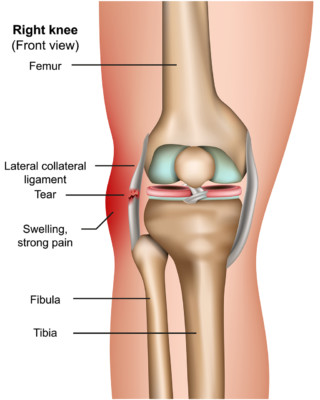Knee MCL Surgery Healing without the Surgery!l
Knee MCL injuries are tough. They take forever to heal and the big ones (grade 3) are usually operated. What if a precise injection of stem cells, using a unique protocol could offer knee MCL surgery healing without the surgery?

Medicalstocks/Shutterstock
The MCL is a ligament that acts like a piece of strong duct tape on the inside of the knee. It’s a stabilizer of the opposite outside part of the knee by protecting against excessive compression or sideways motion of the femur on the tibia bone. It’s often injured in combination with the ACL. Smaller sprains and partial tears (grade 1 and 2) are notorious for very slow healing and can nag for many months or even more than a year. Larger complete tears (grade 3) are usually treated with surgery where the two ends of the torn ligament are sewn together.
LR is a 41 year old woman who tore her MCL and ACL while skiing in Breckenridge in March of 2014. She ended up with a grade 3 MCL tear, so she was looking at surgery to replace her ACL and repair the MCL. Since we have more than enough before and after precise stem cell injection ACL MRIs on this blog, I’ll focus on the MCL today. Above you can see her before image on the left with the red arrows pointing to a dark line that runs vertically (MCL) and then snakes and becomes discontinuous. That’s her completely torn MCL. The MRI on the left also shows the trauma on the outside of the knee (red triangles), where her bone is swollen (white areas). This is happening because with the inside MCL ligament torn, the outside of the knee gets more compression, causing these bone bruises. The MRI on the right was taken 4 months after her Regenexx-SD procedure where her own stem cells were precisely placed into her torn MCL ligament using our unique protocol. Note that the yellow arrows now show a robust vertical line that’s thicker than the old MCL. This is an indication of healing in the ligament. Also note that the yellow triangles on the right now point to normal appearing bone, an indication that the stem cell repair is solid, as the outside of the knee is no longer getting compressed with each step.
The upshot? We’re seeing rapid healing in tough to treat MCL tears that would normally take a year to heal or ligaments like this one, that would normally require a big surgery. So if the ligament will heal with a precise injection of stem cells, why are we operating on the MCL?

If you have questions or comments about this blog post, please email us at [email protected]
NOTE: This blog post provides general information to help the reader better understand regenerative medicine, musculoskeletal health, and related subjects. All content provided in this blog, website, or any linked materials, including text, graphics, images, patient profiles, outcomes, and information, are not intended and should not be considered or used as a substitute for medical advice, diagnosis, or treatment. Please always consult with a professional and certified healthcare provider to discuss if a treatment is right for you.
